Europe
Ukraine confronts tougher fight in push to extend battlefield wins
The Washington Post November 20, 2022
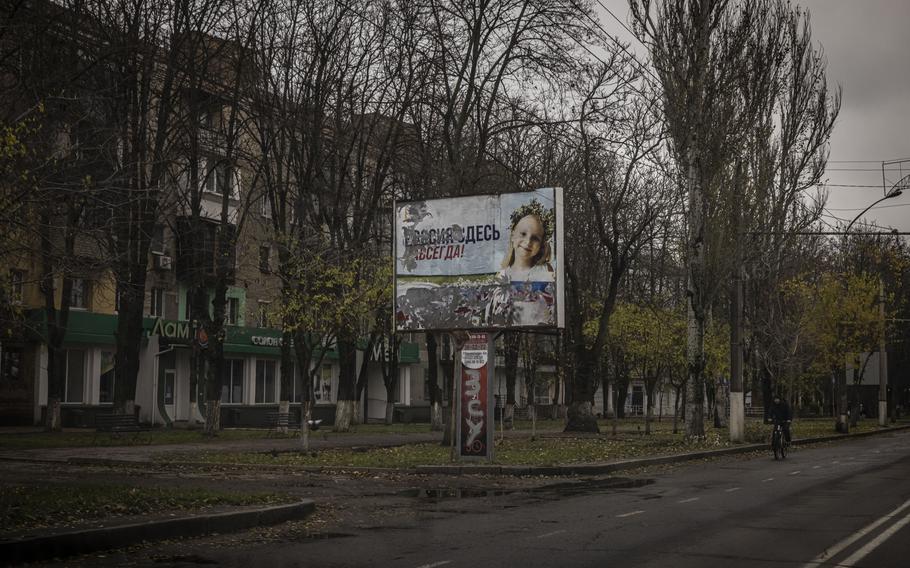
A damaged billboard proclaiming “Russia is here forever” seen from a car in central Kherson city on Nov. 18, 2022. Ukrainian troops pushed Russian forces to flee city after more than eight months of occupation but there is no sign the war in Ukraine will end anytime soon. (Ed Ram/for The Washington Post)
KIVSHARIVKA, Ukraine — Not far from this village on the east bank of the Oskil River, Ukrainian forces have hit a wall of Russian resistance as they try to extend a counteroffensive that just two months ago was sweeping across nearby lands at a stunning clip.
Andriy, a soldier with Ukraine’s 92nd Mechanized Brigade, was not sure what to say on a recent day, when a group of Ukrainian intelligence officers showed up and asked about his unit’s push toward Svatove, a small city in Luhansk region occupied since March.
“How honest should I be?” Andriy said, declining to give his surname or rank because he was not authorized to speak to reporters.
A long pause followed.
“It has been very hard,” he admitted.
After a string of autumn victories for Kyiv, the war in Ukraine is grinding down to another inflection point.
Over 2½ months, Ukrainian forces have impressed the world with their offensive mettle, first by recapturing the northeast Kharkiv region in a stunning rout and later in the south by methodically tightening the vise on a precarious slice of occupied land west of the Dnieper River — forcing Russia’s embarrassing retreat from Kherson city.
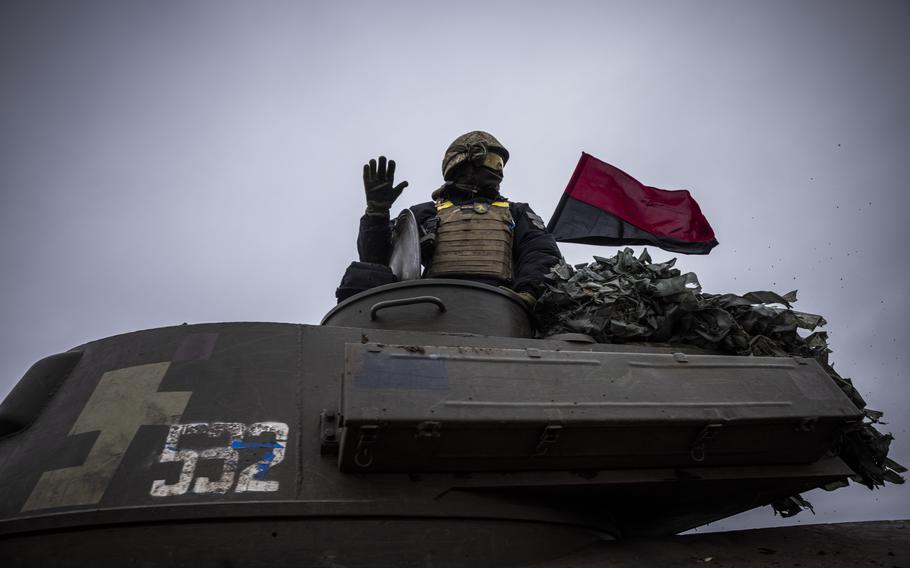
Ukrainian soldiers driving a self-propelled howitzer down a country road on Nov. 18, 2022, in Kherson Region. Russian troops have retreated to the east side of the Dnieper River into more fortified defensive positions, suggesting the war will go on for months. (Ed Ram/for The Washington Post)
The victories have put Kyiv on the front foot, boosting morale and expectations of further success. Ukraine has every incentive to press on with its counteroffensive and retake as much occupied land as possible while Russia is still reeling from personnel shortages and command woes. The Pentagon has vowed to continue arming Kyiv alongside European allies for “as long as it takes.”
But the Ukrainian force now faces obstacles that threaten to slow the advance, with each side gearing up to continue the fight well into next year — and neither side close to what it envisions as victory.
Russian positions on the redrawn front in many cases are more dug in, forcing the Ukrainians to try to penetrate multiple lines of defense. Muddy conditions make maneuver warfare particularly difficult until the ground freezes in midwinter. The Ukrainians, like the Russians, are contending with strained ammunition supplies and exhausted soldiers. Russia also managed to withdraw its best fighting units from Kherson, meaning they likely will appear as worthy foes elsewhere.
The tough fight ahead is apparent outside Svatove, where Andriy said his unit recently tried to take a Russian position in a village but found itself ambushed. Mixed in among newly mobilized Russian troops are special forces groups, Andriy said. Those elite soldiers not only have better experience but are also supported by reconnaissance drones that target Ukrainian troops attempting to advance.
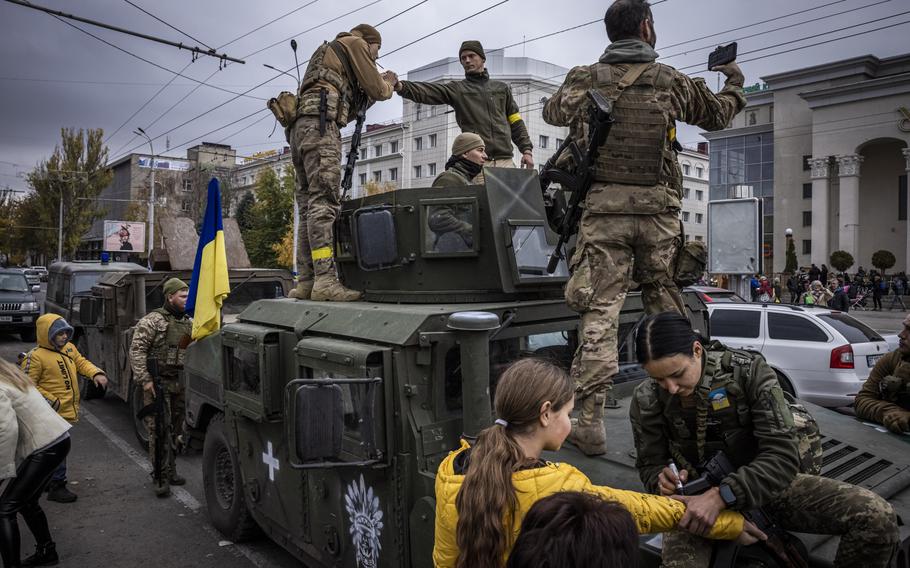
Soldiers met residents and wrote messages on Ukrainian flags in Kherson’s central square, Nov. 16, 2022. The city is celebrating liberation but many people are in need of food and medicine. (Ed Ram/for The Washington Post)
Russia may be too weak to seize the offensive, but Moscow has managed to bolster its defenses to some degree, while also unleashing a relentless bombing campaign on critical Ukrainian infrastructure.
“It turns out they have three lines of defense now,” Andriy said. “But they’re just sitting there in a deep defense. They’re not trying to move forward.”
The situation has led to suggestions, most notably from Joint Chiefs of Staff Chairman Gen. Mark A. Milley, that the time could be ripe for Ukraine to negotiate a political solution to the conflict with Russia — which almost certainly would require surrendering some territory.
In a news conference, Milley said front lines from Kharkiv down to Kherson are “beginning to stabilize” and suggested longer term it was unrealistic to think Ukraine could recapture the remaining 20 percent of its land held by Moscow — “unless,” he said, “the Russian army completely collapses, which is unlikely.”
“The Russian military is really hurting bad,” Milley told reporters at the Pentagon on Wednesday. “You want to negotiate at a time when you’re at your strength and your opponent is at weakness. And it’s possible, maybe, that there will be a political solution. All I’m saying is there is a possibility for it — that’s all I’m saying.”
Defense Secretary Lloyd Austin at the same time promised to continue helping Ukraine protect its population and achieve its aims on the battlefield, which Ukraine’s commander in chief, Valeriy Zaluzhny has identified as retaking all Ukrainian territory held by Russia, including Crimea, which was illegally annexed in 2014.
Austin said he didn’t want to presuppose what was possible for the Ukrainian force, noting that it was up to Kyiv to decide on a good time to negotiate. Officials in Ukraine and elsewhere have warned against any peace talks that would give Moscow breathing room at this juncture.
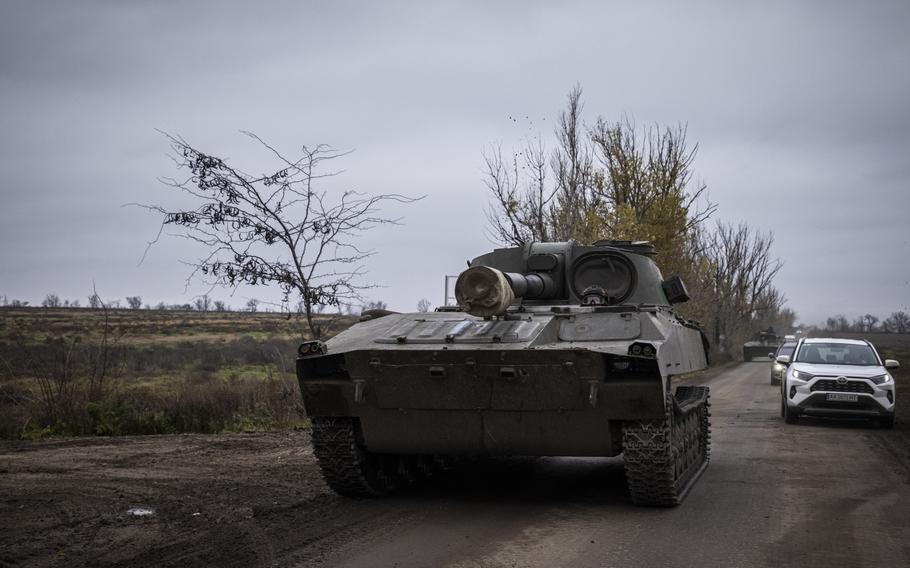
Ukrainian soldiers drive a self propelled howitzer down a country road in Kherson Region, Ukraine. Ukrainian troops are regrouping after liberating Kherson and preparing to continue their fight over winter. (Ed Ram/for The Washington Post)
Yuriy Ignat, a spokesman for the Ukrainian Air Force, said Ukraine does not trust that Russia would abide by any agreement to enter into negotiations and would use any pause in fighting to rebuild its stocks of ammunition and missiles, train its newly mobilized troops and refit and replace damaged equipment.
“Russia needs a truce until spring and then they will strike with everything they have,” Ignat said. “Plus they will make new missiles, strike us with renewed vigor and destroy us completely. That is Russia’s foreign policy and their plan for peace.”
The Kremlin spokesman, Dmitry Peskov, in recent days has accused Ukraine of refusing to negotiate and has said that Kherson city remains Russian territory, insisting that the illegal annexation would be accomplished despite the retreat of Russian troops. “The Ukrainian side does not want any negotiations,” Peskov told reporters on Thursday. “The special military operation continues, and its goals must be achieved.” He also insisted that Russia’s bombing of Ukrainian infrastructure was for military purposes.
In the immediate future, Ukraine is likely to continue offensive operations but at a reduced scale, analysts said. Another sprawling Ukrainian counteroffensive — such as an attempt to push south from the city of Zaporizhzhia to sever Russian supply lines — could be difficult to execute quickly on the heels of recent gains and in the current weather.
Kyiv may not be able to carry out another large-scale offensive until January or February, said Mason Clark, a senior analyst at the Institute for the Study of War, but is likely to mount smaller operations to reclaim territory by the end of the year.
Russian forces are digging new trenches along the border of Crimea and near the Siversky-Donets River in eastern Ukraine that are up to 60 kilometers behind the existing front line, indicating that they are bracing for further Ukrainian advances, Britain’s Defense Ministry said Friday.
“The Ukrainians are definitely on a roll,” said Konrad Muzyka, director of the Poland-based Rochan Consulting. “Morale is incredibly high. Western equipment provides the Ukrainians with an edge.”
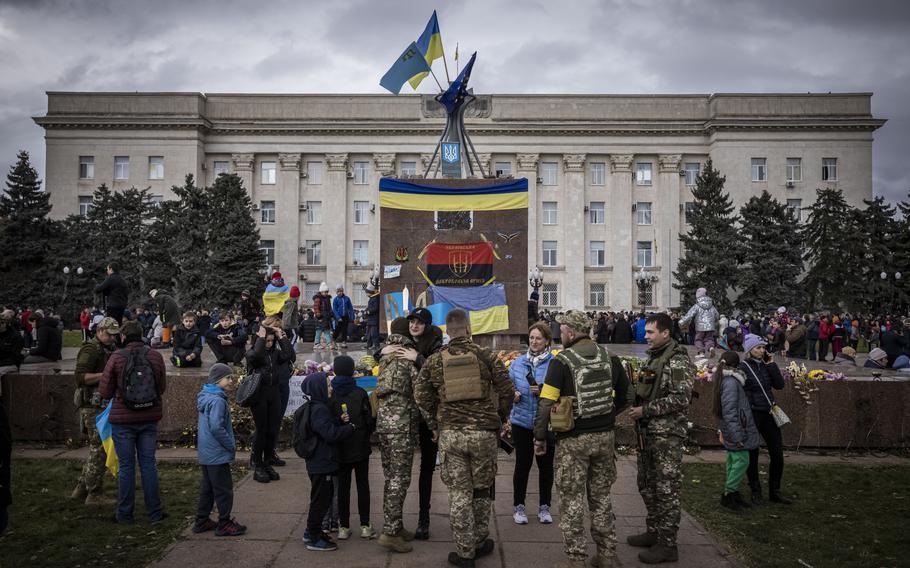
Soldiers hug Kherson residents and pose for photos in the liberated city’s central square, on Nov. 16, 2022. (Ed Ram/for The Washington Post)
But the Russians are now well dug in to their defensive positions, and it is going to be harder to dislodge them than it was in Kharkiv and on the approach to Kherson, he said. There are no obvious weak spots along the Russian lines that could readily be exploited, as was the case earlier this fall, he said.
“Now it’s going to be very challenging for the Ukrainians to create conditions that would ultimately result in a maneuver that would lead to a large-scale defeat of Russian forces,” Muzyka said. “Russian forces are poorly equipped, poorly trained, but their advantage is mass. It is not looking at the quality of its forces — but to hold the line.”
Fighting is likely to continue despite the adverse winter conditions, as Ukraine looks to press its advantage before even more mobilized Russian soldiers show up to bolster Moscow’s defenses.
Russia had 90,000 troops on the front lines when the conscription drive began — and has since added as many as 100,000, according to an official from a European NATO country, who spoke on the condition of anonymity to discuss sensitive security matters.
As many as 200,000 more Russian forces are being trained and will arrive in the coming months, likely in at least slightly better shape than the underequipped and ill-prepared men who have arrived so far, the official said. This could help reconstitute Russian fighting power heading into the spring.
“It’s a lot of men,” the NATO country official said. “We all know their quality is poor. They lack equipment, They lack training. Yet there is also a certain degree of quality in quantity — and speed [of getting them to the front].”
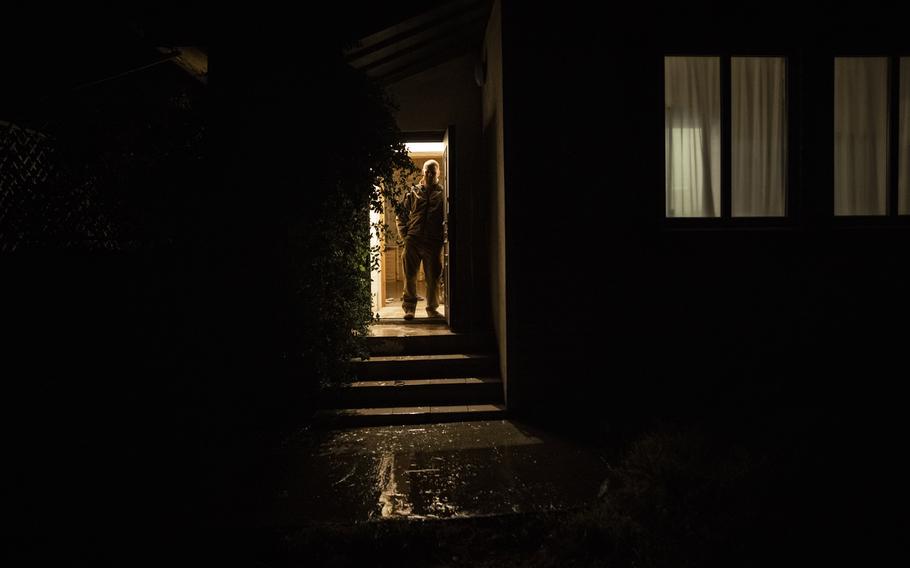
Capt. Andriy Pidlisnyy stands in the doorway of his soldiers’ new base Nov. 17, 2022, in Kherson Region, Ukraine. Ukrainian forces are regrouping after liberating Kherson and preparing to fight over winter. (Ed Ram/for The Washington Post)
On a recent day in the Kherson region, Capt. Andriy Pidlisnyy, whose unit was among those advancing down to the Dnieper River during the recent counteroffensive, said it was difficult to fathom how to continue pushing the Russians back now that the front line has settled along the river.
“If it were easy, then Russia wouldn’t have crossed over to the other bank,” Pidlisnyy said. “It is precisely because of the logistical difficulties and heavy personnel losses that they had to retreat.” He added: “To do some smaller force operations across the river is possible, but a full-scale big offensive is difficult.”
At its narrowest point, the Dnieper is still about one-third of a mile wide. That means the Ukrainians would need a pontoon bridge to move across it. “Those bridges take a while to put in place and then are very quickly destroyed,” Pidlisnyy said.
“I think there will be some attempts,” he said. “But it’s much more rational to try to move through the Zaporizhzhia region and advance by land.” Pidlisnyy said he doesn’t expect the Russians to attempt another assault on Kherson city anytime soon.
“They’ve already moved their best units,” he said. “There’s only a small part of Russian paratroopers left in the area.”
As the conflict settles into a war of attrition, each side is attempting to bolster its forces, equipment, and ammunition.
The NATO country official warned that while Russia has lost a significant number of tanks, infantry fighting vehicles and armored personnel carriers, it still has thousands of vehicles in storage, and noted that Russian manufacturing plants for artillery shells are working double and triple shifts to sustain the immense amount of firepower that Moscow is expending.
The United States and its European allies, meanwhile, are scrambling to keep Ukraine supplied with sufficient weapons and ammunition, which enabled Ukraine’s battlefield successes in recent months.
“The West has got into a challenging situation,” the NATO country official said. “A lot has already been given. Western nations need to dig deeper into their stocks. The efforts needed now are more long term and more strategic.”
Despite the calls for negotiations, Kyiv and Moscow are taking steps to prepare for continued warfare.
“We are at a stage where both sides are tired, both sides are exhausted,” said Dara Massicot, a Russian military analyst at the RAND Corporation. “But they are not ready to stop fighting.”
Khurshudyan and Hrabchuk reported from Kivsharivka and Kherson. Sonne reported from Washington. Sly reported from Kyiv.
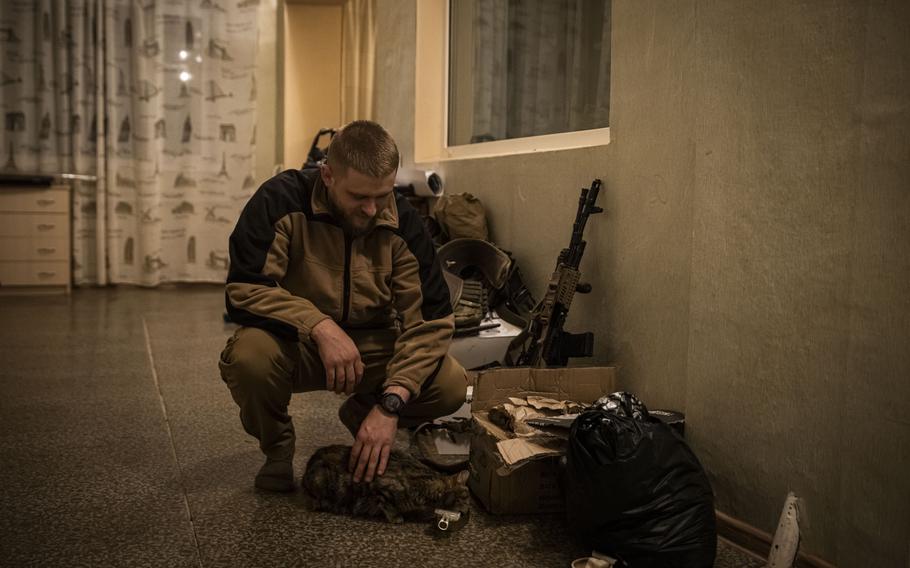
Capt. Andriy Pidlisnyy strokes a cat as it eats in the soldiers’ new base Nov. 17, 2022, in Kherson Region, Ukraine. Ukrainian troops are preparing for a long fight over winter after the Russians retreated to more fortified defensive positions on the east side of the Dnieper River. (Ed Ram/for The Washington Post)